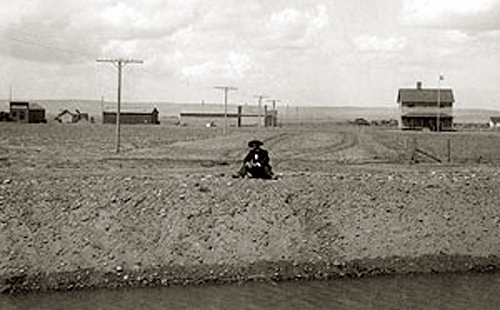
Powell, Wyoming, 1909.
In the foreground is the Garland Canal which reached what was to become Powell in 1908. The two-story
building with the flag in the front is the headquarters building for the
United States Bureau of Reclamation in charge of the construction of the
Shoshone Project for the Bureau. Upon the completion of the project and sale of the
lands to settlers, the building became the headquarters of Shoshone Irrigation District.
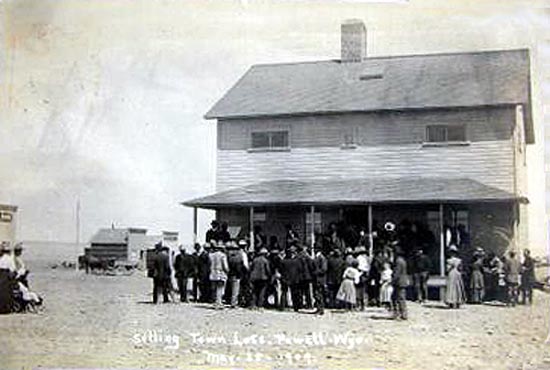
Townsite lot sale, 1909.
The building is now gone. It was located across the street from the current location of the Homesteader Museum on the corner of
S. Clark and E. 1st Street.
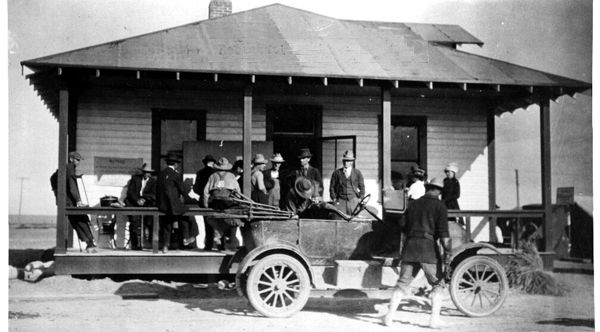
Reclamation Office, 1917.
The Homesteader Museum is located in a former American Legion Hall constructed in 1934. The Armerican Legion Post was formed in 1919 and was named for
two Park County men William Frances Ettinger and Guy W. Hughes who died during World War I.
The museum has exhibis of early homesteads on the Flats and presents
programs on the history of Park County. One program presented by former District Judge Hunter Patrick, author of "Better Known as Boxcar Murphy," dealt with a hobo who was a
local character for many years in Powell and northern
Wyoming and southern Montana. "Murphy" was not his real name which was James H. Norman. Allegedly he
adopted Murphy when he worked in the mining industry in Butte. In addition to hopping freights Boxcar would hitch rides.
A disconcerting habit was his spitting chewing tobacco juice on the vehicle floor. One time, he spit out the window, only to discover that the window
was closed. He would raise spare change by selling fish he had caught using road kill for bait. One time he allegedly
attempted to thumb a ride on a backhoe, asking the driver if he could ride in the bucket. Many backhoes have a front-end bucket.
which tend to bounce up and down, it would not have been a comfortable ride.
Boxcar Murphy was undoubtedly a product of the postwar surge in the number of hoboes. But in a sense, Judge Patrick's account of Boxcar remind us of
a generally forgotten period of Wyoming history associated with the Great Depression and the earlier depression of 1893 when the "Knights of the Road" infected the railroads of the
West. "Hobo camps" or "jungles" flourished at most railroad division points. It was there that it was
easier to hop a freight. It has been estimated that between 1890 and 1930 there were a million hoboes riding the rails.
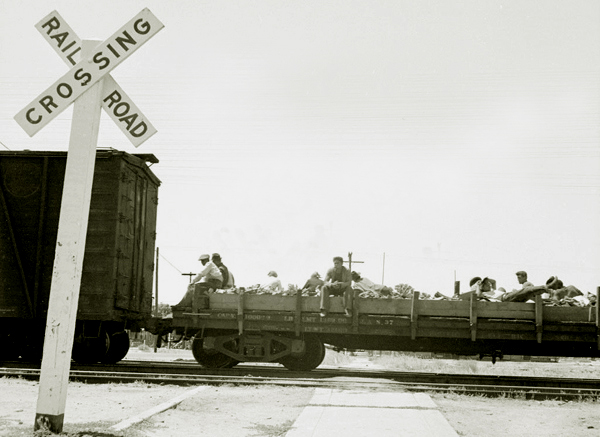
Hoboes on a Train, 1930's
Hopping freights was a dangerous
method of travel. The Interstate Commerce Commission estimated that between 1898 and 1908 some
48,000 hoboes were killed approximately the same number of railway workers who died. Some hoboes were murdered. Others fell from the trains and many
froze to death either from the weather or being trapped in refrigerator cars. Refrigerator cars had the advantage that if they were empty and the side doorlocked,
access could still be obtained by opening the hatch on top.
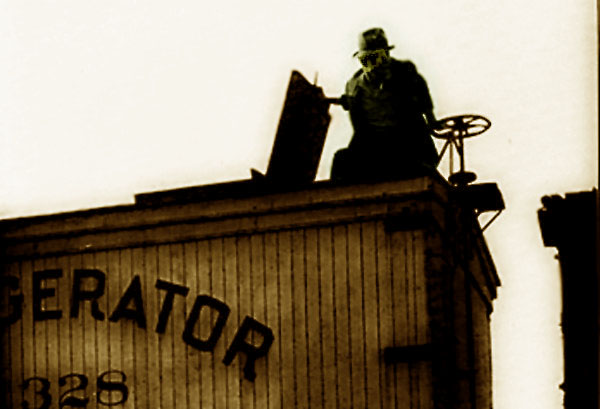
Hopping a refrigerator car.
Still others were killed by railroad "bulls." A railroad
bull was a railroad detective employed to chase off the hoboes. One of the more infamous in the 1890's was the Union Pacific's
Jeff Carr later remembered for his role in the
unsuccessful efforts to apprehend Butch Cassidy and the Sundance Kid.
Jack Black in his "You Can't Win," MacMillan Company, New York (1926), quoted the description of Carr by another bum called Smiler:
"He's a railroad bull and he is bum simple -- simple minded
on the subject of killing bums. I you run
he'll shoot you; if you stand he'll get you six months, and he'd rather you run."
Black continued:
I learned all about Carr later, and his feud with the bums. They made many efforts to kill him, but never
succeeded. He was later put in charge of the railroads
train-robber detail, but he never killed any train robbers and the bums rambled through
Cheyenne in peace.
"Jack Black" was, no doubt, not the author's real name. Black's book made it to the best seller list, but Black did not achieve
happiness.In 1932 he disappeared. Jack London in his 1907 account of his riding the rails in 1893 amd 1894 explained that most hoboes
had a "monica":
"'Monicas' are the nom-de-rails that hoboes assume or accept when thrust upon them by their fellows. Leary Joe, for instance, was timid, and was so named by his fellows."
Of Carr London wrote:
When hoboes pass the word along, concerning a town, that "the bulls is horstile," avoid that
town, or, if you must, go through softly. There are some towns that one must always go through
softly. Such a town was Cheyenne, on the Union Pacific. It had a national reputation for
being "horstile," — and it was all due to the efforts of one Jeff Carr (if I remember his
name aright). Jeff Carr could size up the "front" of a hobo on the instant. He never entered
into discussion. In the one moment he sized up the hobo, and in the next he struck out with
both fists, a club, or anything else he had handy. After he had manhandled the hobo, he started
him out of town with a promise of worse if he ever saw him again. Jeff Carr knew the game.
North, south, east, and west to the uttermost confines of the United States (Canada and Mexico
included), the man-handled hoboes carried the word that Cheyenne was "horstile." Fortunately,
I never encountered Jeff Carr. I passed through Cheyenne in a blizzard. There were eighty-four
hoboes with me at the time. The strength of numbers made us pretty nonchalant on most things,
but not on Jeff Carr. The connotation of "Jeff Carr" stunned our imagination, numbed our
virility, and the whole gang was mortally scared of meeting him.
The car in which London was riding was a refrigerator car and a mite bit crowded. London described his entrance into the car:
I found the car — a big refrigerator car with the leeward door wide open for ventilation.
Up I climbed and in. I stepped on a man's leg, next on some other man's arm. The light was
dim, and all I could make out was arms and legs and bodies inextricably confused. Never was there such a tangle of humanity. They were all lying in the straw, and over, and under, and around one another. Eighty-four husky hoboes take up a lot of room when they are stretched out. The men I stepped on were resentful. Their bodies heaved under me like the waves of the sea, and imparted an involuntary forward movement to me. I could not find any straw to step upon, so I stepped upon more men. The resentment increased, so did my forward movement. I lost my footing and sat down with sharp abruptness. Unfortunately, it was on a man's head. The next moment he had risen on his hands and knees in wrath, and I was flying through the air. What goes up must come down, and I came down on another man's head.
What happened after that is very vague in my memory. It was like going through a
threshing-machine. I was bandied about from one end of the car to the other.
Those eighty-four hoboes winnowed me out till what little was left of me, by some miracle,
found a bit of straw to rest upon. I was initiated, and into a jolly crowd.
The occupants of the car had not eaten for a day and a half. They were able to scrape up enough money to pay for a telegram to
Grand Island to let the sheriff know they were coming. The sheriff knew that if he jailed them he would have to feed them for several days.
He therefore arranged for them to eat in local restuarants and then put them back on the train. Feeding they one
meal was cheaper than jailing them.
The manner in which the hobos would spread the word was through the use of symbols on bridge abutments or water tanks. The water tank
at Sherman Hill provided the warning of Cheyenne. Carr's reputation was such that the hoboes would leave a train
before they arrived at Cheyenne and then reboard after walking though town. It didn't always work. Advance word was sometimes received from
Laramie. Twice in 1908 forty-some hoboes came into town and were rounded up to work in chain gangs on the city streets.
Occasionally errors were made. A newspaper writer was in Sheridan was robbed, his railroad ticket and money taken. He was put off the
train as a hobo in the railroad yard. He apparently died from exposure. It turned out that he was a Mason and was thus
given a nice funeral. Carr's methodology was simple.
Longtime hobo Charles Elmer Fox in his "Tales of an American Hobo," University of Iowa Press, 1989,wrote:
One notorious railroad dick in the Union Pacific
yards at Cheyenne, Wyoming, used to ride his big
white horse alongside a train and knock any bo
that he could reach off the train with his two-foot-Iong
hickory club and hopefully kill him. If he saw a bo riding
the top of a train he would try to shoot him off with his
revolver.
Consequently old Jeff killed a lot of men during his years
at Cheyenne. The law of the inevitable finally caught up
with him, he tackled the wrong man and they found old Jeff
lying alongSide the track shot full of holes and beat to a pulp
with a piece of iron, and the killer was never caught.
Jeff was killed in 1925 and I didn't hit the road until
1929, so I was spared the misery of a confrontation with
Mr. Carr! The memory of old Jeff lived on for many years in
the hobo jungles and rail yards all across the country. As
the saying goes, quote, "He had put the fear of God in hoboes
far and wide."
The hickory "club" which Carr used, was a brakeman's club used as a lever to tighten up or snug
the brakes of freight cars before the days of air brakes. Even after air brakes hand brakes had to be used
if the car was disconnected from a train. The club was actually slightly longer than three feet.
In some instances the hickory club was replaced with a lever made of metal. It was, however, still called a
"hickory."
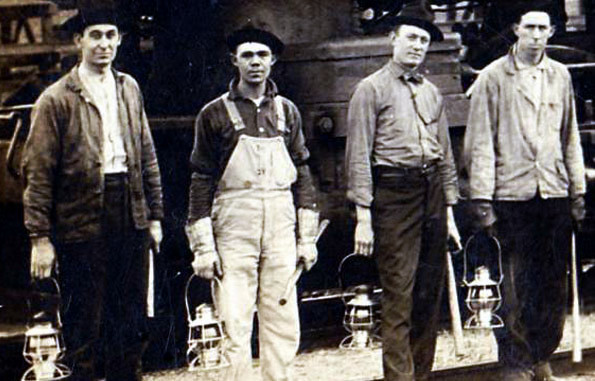
Brakemen standing next to locomotive, holding brakemen's lanterns and
hickories.
The manner of Carr's death was somewhat exaggerated. He died a natural death in Texas in 1916. Nevertheless, at least one other author
described in a more grusome narritive, Carr's demise. See Kenneth Allsop, "Hard Travellin" who tell us that Carr was killed by being beaten
with a coupling pin in a fight
with a hobo.
Another former hobo, Walter Ballard, recalled the scene at Chadron in the early 1930's:
We seen a freight asitting over there, and there was so many people on it it
looked like blackbirds all over it. We was scared to death to ride one, afraid we'd get throwed
off or beat up. And believe it or not, when we got ready to go, that old brakeman hollered, '
All aboard!' [Laughs.] 'All aboard.' Just like it was a passenger train.
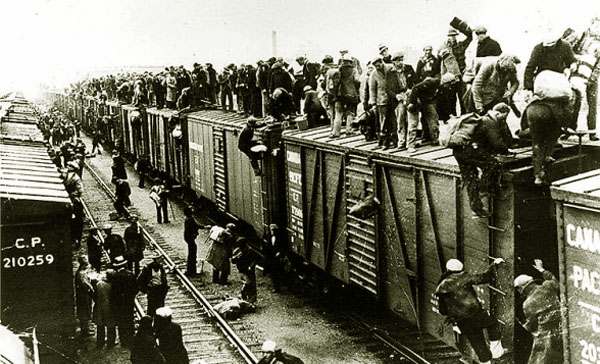
Train Hopping, 1930's.
Ballard later was employed by the W.P.A. With the exception of Cheyenne where hoboes were driven off by mounted bulls, everywhere there was a large railroad yard there were hobo camps or
hobo jungles. In Green River, the camp was located next to the railroad bridge, in Casper it was along the
North Platte, in Greybull the camp was across the tracks from the elevator.
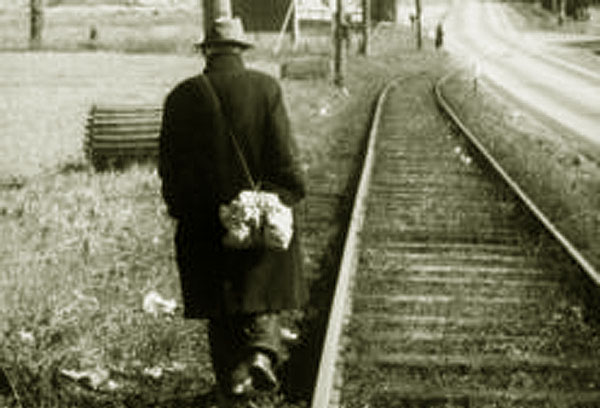
An unidentified hobo walking along side a side track.
Train hopping continues today, but to a lesser extent. Railroads have, however, had to adapt. Railroad cars which carry
new automobiles are now enclosed. The keys to the new cars are kept in the cars. The hobos would ride in the nice new cars listening to the
radio. The batteries would be drained. Public libraries have a problem. During hot or cold wweather, the hoboes
find a compulsion to read. In one library, patrons complained of naked hoboes taking baths in the sinks of the
restrooms.
For some years in Powell, Boxcar Murphy lived in the Essex Cabins on the south side of the tracks. He allegedly arrived in Powell as a result of his falling asleep in a freight car he had hopped.
Murphy was not the only hobo in Park County. Alan Simpson recalled from when he was about six years old the hoboes in
Cody:
I remember the hobos came on the train. There was a train to Cody; that was the end of the line.
And it was funny how you'd be out with all your little pals, six, seven years old, in
'37, '38, and these guys would be cooking stuff, and talking to you, and telling you
stories. Nowadays, no sane person would ever allow their six-year-old children to sit with a
bunch of guys, you know, cooking nail soup, telling stories. Gosh. I mean, that's what we did.
We were hunting rattlesnakes and prairie dogs, and that's what we did.
Writer's note: "nail soup" to which Senator Simpson referred is from an old tale dating back to the Middle Ages.
In the story a tramp comes to a town which itself is in the middle of a famine. Nobody would share what
little food that they might have. The tramp begs for food but none would share.
He then he takes a pot out of his knapsack, fills the pot with water, lights a fire and as the water heats he places a rusty nail in the pot.
He tastes the the soup and smacks his lips. The townsfolk watch. One, out of curiosity, asks what he is doing.
He replies that he has a magic nail which will make the most delicious soup. He tastes it again and tells the onlooker that it is delicous, but all
it needs to be even better is a little cabbage. The townsman produces a cabbage which he had been hiding from the other
townsfolk. It is placed in the pot. Another townsman comes and asks what he is doing, He explains about the magic nail. all. the soup needs to be even better is a few carrots. Some carrots
are produced. Others ask and the explanaton is given that maybe with a bit of salt beef, the soup would be fit for the King.
And so it went, carrots, turnips and other ingredients. And when the soup was done, the tramp fished out the
nail, wiped it off, put it in his knapsack and invited the townfolk to share in the soup. They all agreed it was indeed
the best soup they ever had, fit for the King. It satisfied their hunger. Some offered to buy the nail, but the tramp refused and went upon his way.
Moral, if all contribute a little bit, a greater good can be done. In essence the legend of nail soup was an
early description of a covered dish supper. Nail soup is sometimes also referred to as Stone Soup.
In 1960 Boxcar Murphy died in Thermopolis at age 90.
Music This page:
BIG ROCK CANDY MOUNTAIN
1. On a summer day
In the month of May
A burly bum came hiking
Down a shady lane
Through the sugar cane
He was looking for his liking
As he roamed along
He sang a song
Of the land of milk and honey
Where a bum can stay
For many a day
And he won't need any money
Chorus:
Oh the buzzin' of the bees
In the cigarette trees
Near the soda water fountain
At the lemonade springs
Where the bluebird sings
On the big rock candy mountain
2. There's a lake of gin
We can both jump in
And the handouts grow on bushes
In the new-mown hay
We can sleep all day
And the bars all have free lunches
Where the mail train stops
And there ain't no cops
And the folks are tender-hearted
Where you never change your socks
And you never throw rocks
And your hair is never parted
Chorus:
3. Oh, a farmer and his son,
They were on the run
To the hay field they were bounding
Said the bum to the son,
"Why don't you come
To that big rock candy mountain?"
So the very next day
They hiked away,
The mileposts they were counting
But they never arrived
At the lemonade tide
On the big rock candy mountain
Chorus
Next page: Powell continued, Early stores and growth.
|



